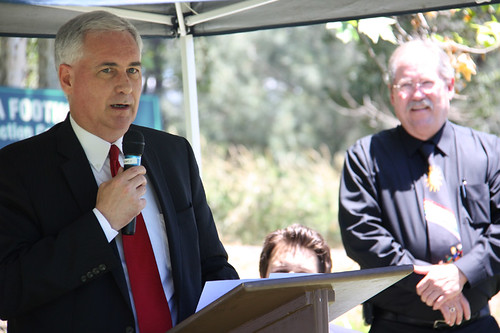
Most people are unfamiliar with the town of Grass Valley, California- a small rural area located in the pocket of northern Nevada County with a population of 12,860 and 4.7 square miles of land. So, just what can someone find in this small town? A lot of community support and dedication. This commitment was apparent at the groundbreaking ceremony for Community Recovery Resources’ new Center for Hope facility, a residential drug treatment center.
Congressman Tom McClintock joined CoRR CEO Warren Daniels, USDA Rural Development Specialist Anita Lopez, Sierra Foothills Construction Director Keoni Allen, and many other partners and community supporters to celebrate the groundbreaking of Western Nevada County’s newest residential drug treatment facility.
Everyone was eager to commemorate the moment because identifying the proper funding was anything but easy. CoRR could not afford a regular loan with a bank because interest rates were too high and loan terms were terms too short. However, USDA Rural Development was able to provide a 40-year low interest loan for $9.3 million through the Community Facilities Direct Loan program. Their effort to find an appropriate loan demonstrates the strong determination within the community.
And their efforts will not go unnoticed within the community- not only will the project benefit potential patients, but the entire county as well. Sierra Foothills Construction estimates 90 percent of the work will be completed locally, resulting in approximately 400 new jobs and almost $6.8 million of the funds remaining in Nevada County. In addition, once completed, the facility will employ 40 counselors. With the local unemployment rate of 12.3 percent, well above the state average, these economic benefits are much needed.
Fighting drug abuse in Nevada County has been a difficult battle, but with the completion of the Center for Hope facility in summer 2012, Nevada County will be well equipped to confront the growing rate of substance abuse. The new 47,000 square foot facility will provide services including therapy, counseling, nutritional and educational classes to promote self-sufficiency and a full transition back into the local community for CoRR patients. The availability of these services will help an estimated 2,000 people annually to recover from substance abuse and other related health behavior disorders.

“This is your victory,” McClintock told the crowd gathered at the event. “This is funded, and will ultimately succeed, because this community wanted it and is 110 percent behind it.”
To find out more about how USDA Rural Development’s Community Facilities program can assist your rural community, click here.
